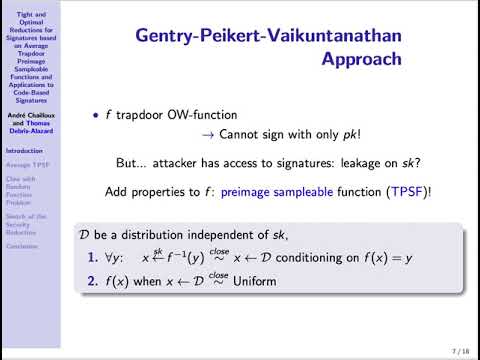CryptoDB
Tight and Optimal Reductions for Signatures Based on Average Trapdoor Preimage Sampleable Functions and Applications to Code-Based Signatures
| Authors: | |
|---|---|
| Download: | |
| Abstract: | The GPV construction [ GPV08 ] presents a generic construction of signature schemes in the Hash and Sign paradigm and is used in some lattice based signatures. This construction requires a family $$mathcal {F}$$ of trapdoor preimage sampleable functions (TPSF). In this work we extend this notion to the weaker Average TPSF (ATPSF) and show that the GPV construction also holds for ATPSF in the Random Oracle Model (ROM). We also introduce the problem of finding a Claw with a random function (Claw(RF)) and present a tight security reduction to the Claw(RF) problem. Our reduction is also optimal meaning that an algorithm that solves the Claw(RF) problem breaks the scheme. We extend these results to the quantum setting and prove this same tight and optimal reduction in the QROM. Finally, we apply these results to code-based signatures, notably the Wave signature scheme and prove security for it in the ROM and the QROM, improving and extending the original analysis of [ DST19a ]. |
Video from PKC 2020
BibTeX
@article{pkc-2020-30318,
title={Tight and Optimal Reductions for Signatures Based on Average Trapdoor Preimage Sampleable Functions and Applications to Code-Based Signatures},
booktitle={Public-Key Cryptography – PKC 2020},
series={Public-Key Cryptography – PKC 2020},
publisher={Springer},
volume={12111},
pages={453-479},
doi={10.1007/978-3-030-45388-6_16},
author={André Chailloux and Thomas Debris-Alazard},
year=2020
}

